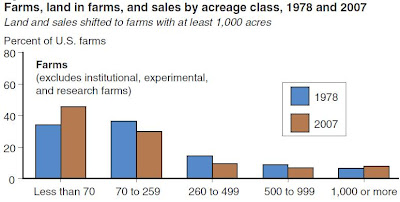Note that this is Part IV of my breakdown of this summer's USDA report on the changing sizes and productivity of farms. This post shows how the overall number of farms has changed over the years as compared to their size and productivity.

U.S. Farms: Numbers, Size, and Other Characteristics
After peaking at 6.8 million farms in 1935, the number of U.S. farms fell sharply until the early 1970s. Falling farm numbers during this period reflect growing productivity in agriculture and increased nonfarm employment opportunities. Growing productivity led to excess capacity in agriculture, farm consolidation, and farm operators leaving farming to work in the nonfarm economy.
The decline in farm numbers slowed in the 1980s and essentially stopped in the 1990s. The greater stability in farm numbers, however, masks shifts in the size distribution of farms. For example, though farm numbers stabilized from 1978 to 2007, the number of farms operating fewer than 70 acres increased 12 percentage points, the number of “thousand-acre farms” increased 1 percentage point, and the number of farms in all acreage classes in between decreased.

acreage class
The shift to farms with more than 1,000 acres is more marked when examined in terms of these operations’ land in farms (up 12 percentage points) or market value of sales (up 15 percentage points). Note that farms do not necessarily own all the land they operate; they can also rent land. For example, a farm operating 1,000 acres could own 500 acres and rent 500 acres, or even own no land at all and rent 1,000 acres.

The shifts in farms and acres among acreage classes between 1978 and 2007 are reallocations of a fairly stable farm count and total acres of farmland. Sales grew more rapidly during the period, however, reflecting more output per hour of labor. A recent ERS study found that two-thirds of the growth in U.S. agricultural output per hour between 1981 and 2004 came from technological change, such as biotechnology, improved animal husbandry, and improvements in machinery and chemicals.

Larger farms—like thousand-acre farms—were better able to take advantage of these technological developments and increased their share of sales.
source: usda

After peaking at 6.8 million farms in 1935, the number of U.S. farms fell sharply until the early 1970s. Falling farm numbers during this period reflect growing productivity in agriculture and increased nonfarm employment opportunities. Growing productivity led to excess capacity in agriculture, farm consolidation, and farm operators leaving farming to work in the nonfarm economy.
The decline in farm numbers slowed in the 1980s and essentially stopped in the 1990s. The greater stability in farm numbers, however, masks shifts in the size distribution of farms. For example, though farm numbers stabilized from 1978 to 2007, the number of farms operating fewer than 70 acres increased 12 percentage points, the number of “thousand-acre farms” increased 1 percentage point, and the number of farms in all acreage classes in between decreased.

The shift to farms with more than 1,000 acres is more marked when examined in terms of these operations’ land in farms (up 12 percentage points) or market value of sales (up 15 percentage points). Note that farms do not necessarily own all the land they operate; they can also rent land. For example, a farm operating 1,000 acres could own 500 acres and rent 500 acres, or even own no land at all and rent 1,000 acres.

The shifts in farms and acres among acreage classes between 1978 and 2007 are reallocations of a fairly stable farm count and total acres of farmland. Sales grew more rapidly during the period, however, reflecting more output per hour of labor. A recent ERS study found that two-thirds of the growth in U.S. agricultural output per hour between 1981 and 2004 came from technological change, such as biotechnology, improved animal husbandry, and improvements in machinery and chemicals.

Larger farms—like thousand-acre farms—were better able to take advantage of these technological developments and increased their share of sales.
source: usda